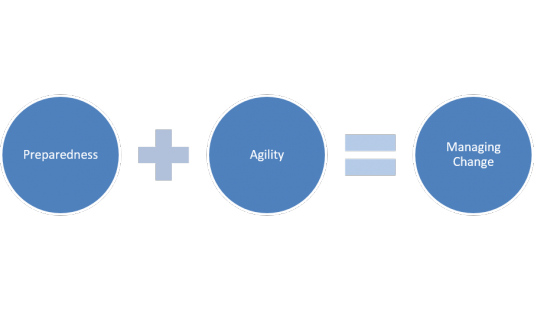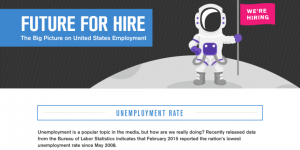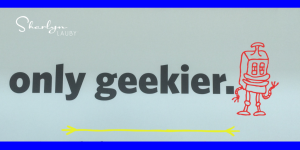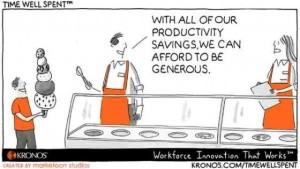Sharlyn J. Lauby's Blog, page 166
December 6, 2015
High Performing Companies Know How to Manage Change
Want a competitive edge? The key is all about the way a company knows how to manage change.
It totally makes sense. Dr. Peter Senge shared with us that learning organizations strive to continuous improve. And continuous improvement makes the organization better. Well, learning and continuous improvement involve the way we manage change.
Change is a critical differentiator in today’s business world. Being able to recognize the need for change and incorporate necessary changes helps both individuals and organizations stay on top of their game. There are two competencies for managing change effectively:
Preparedness is being able to anticipate and take advantage of change. Many people are able to see change coming. It’s about leveraging the opportunity.
Agility is defined as the ability to move quickly and decisively. It’s one thing to see the change coming and another to react to it.
If the way we manage change were a formula, maybe it would look something like this:
Once a company knows that change is necessary, they have to decide how they are going to spend their time. Do they wait for change to arrive and grouse the entire time about how it’s going to wreck their business? Or is the time spent putting a plan in place to potentially mitigate any losses and possibly benefit from the change? Because if your competitive set is busy griping then it only makes good business sense to set yourself apart by embracing the change.
The only way a company can really benefit from change is when their employees are capable of being agile in preparing for change. That means having a well-defined and executed strategy where talent is concerned. Two thing companies can do to align their business and talent strategy include:
Goal setting and performance management has a clear purpose and is connected to organizational objectives.
Leadership development plays a huge role in high-performing workplaces, especially when management is held accountable for their performance.
Becoming a high performance company comes down to hiring the right people and giving them the tools to succeed. That includes communicating expectations, training where appropriate and developing individuals for future needs. Want a competitive edge? Develop the best darn group of employees you can. They’ll make sure managing change is a no-brainer.
Image courtesy of Sharlyn Lauby
The post High Performing Companies Know How to Manage Change appeared first on hr bartender.






December 4, 2015
The Big Picture on Hiring [infographic] – Friday Distraction
The jobs conversation isn’t going away. What I mean by that is the challenges of finding, hiring, and retaining talent will be with us for a while.
This infographic, courtesy of Jobvite, really offers a big picture view of where the employment market is right now. The U.S. unemployment rate is at pre-Great Recession levels. That being said, there are some regions of the country that have higher rates of unemployment and haven’t completely bounced back.
One of the things I found particularly interesting were the industries that are currently “hot.” Health care has been on the radar for a while. But check out cyber security. I just started reading SmartBrief’s latest newsletter on cyber security and, from what I’ve been reading, this is going to be an in-demand field for a very long time.
Whether you’re an Individual or an organization, you need to notice these trends. If you’re looking for a new opportunity, information like this can show you what is happening around the country. You should know the employment prospects for your region, industry and profession. Same goes for organizations trying to find talent, you need to know the best places to source.
The good news is that hiring is taking place. We all need to be up for the challenge.
The post The Big Picture on Hiring [infographic] – Friday Distraction appeared first on hr bartender.






December 3, 2015
Employee Retention Strategy: Technology Is an Essential Tool
Employee engagement and retention continue to be top challenges for business. In dealing with these issues, organizations have to recognize that they are related. We can’t engage employees that don’t stay and employees won’t stay if they’re not engaged. So in developing our employee retention strategy, we have to look for those tools and solutions that we help us accomplish both.
Technology is one of those things.
Many organizations use technology to recruit. Even if all you’re doing is posting jobs on LinkedIn, you’re using technology. Employees have a level of expectation that they will use technology at work. It could be in onboarding paperwork, employee self-service, or performance management. Employees are comfortable with technology in their work.
That doesn’t mean that technology is a replacement for human interaction. We still need face-to-face conversation. For example, it’s probably not a good thing to do a stay interview online. The goal is to find out how to keep an employee engaged so you can retain them. It could send a mixed message to do that via an online survey.
But organizations could use technology to keep track of who has conducted stay interviews or record notes of the interview to possibly spot trends that need to be addressed. Technology solutions don’t have to be the entire process. They can be a very effective step in the process.
Technology also allows organizations to be in multiple places at the same time. Many organizations are realizing that engagement (and ultimately retention) start with the hiring process and the candidate experience. But the days of spray and pray recruiting are over. We must be more strategic in our employee retention strategy. That’s where technology comes in.
Career portals, talent networks, social sharing and recruitment marketing are all technology solutions and tools that allow companies to tailor their message and direct candidates to the right information. Technology allows us to control the message so the candidate knows exactly what to expect before they ever apply.
Getting our arms around what technology can do for our business isn’t easy. There are many technology solutions available. We have to understand what we are trying to accomplish, so we choose the solution that meets our needs. This really came into focus for me recently when I was having some challenges with my internet browser, Google Chrome. I was getting increasingly frustrated with it so I decided I was going to switch to Internet Explorer. I know, I know – Internet Explorer?! …but I was really frustrated. So I spent days moving all my bookmarks, etc.
As soon as I did it, I immediately regretted it. I missed my Chrome extensions, etc. That was when I realized, I didn’t have to choose. I was getting frustrated over nothing. I can have a primary and secondary browser. Voila! Problem fixed.
It’s the same with other forms of technology. We don’t have to choose one program or platform. That’s what makes technology so great. If we let it, we can increase our effectiveness by letting technology be a part of our employee retention strategy. There’s no one way to engage employees. We need to let technology help us. Just be smart about the role it plays.
Let technology do what it does best. So you can do what you do best.
Image courtesy of Sharlyn Lauby
The post Employee Retention Strategy: Technology Is an Essential Tool appeared first on hr bartender.






December 1, 2015
10 Steps for Identifying Your Transferable Job Skills
(Editor’s Note: Today’s post is brought to you by Capella University. Capella is an accredited online university dedicated to providing an exceptional, professionally-aligned education that puts you in the best position to succeed in your field. They offer bachelor’s, master’s and doctorate degrees as well as certificate programs for human resources and business professionals. Enjoy the post!)
When you think about the jobs you’ve had over the years, do you know the reason you were selected? I remember years ago, I went to work at an airline. After a few months of working there, my boss told me why she hired me. “Because you didn’t have any airline experience.” She wanted someone who knew HR and could provide a fresh set of eyes about HR in that industry.
Given the conversation about transforming human resources, it wouldn’t be a surprise that some organizations will want to hire professionals with human resources knowledge but limited experience. Or professionals with experience in another industry. They can provide a fresh set of eyes to policies, procedures, etc.
For candidates, this means being able to identify and sell the transferable job skills you’ve acquired along the way (in other roles and industries) during the hiring process. Here are ten steps to show you how to do it:
Define what your skills are. This might sound very basic but you won’t be able to figure out your transferable job skills if you can’t identify a skill (versus knowledge or abilities.) Here’s something I wrote a while ago that defines each.
Analyze your current and previous jobs. What are the common skills across each? This can help you notice those skills that might be transferrable to any job.
Review your past performance. What did your managers say you did really well? And what are those areas you need to improve? It can offer you some perspective on those skills that others associate with you.
Have an honest moment with yourself. What do you like to do? It makes no sense to sell transferable job skills you don’t enjoy.
Understand what skills are required in your desired role (and the industry you’re considering.) For example, in human resources you can turn to the SHRM book, “Defining HR Success: 9 Critical Competencies for HR Professionals” which outlines the competency model or the HR competency model developed by Dave Ulrich.
Match your top skills with the skills required in the job. Those common skills are the transferable ones. At this point, don’t worry about the number of skill-matches. Take time to look at the list before moving on to the next step.
Then consider grouping your transferrable job skills into easy to remember terms. Maybe no more than five. That way, during an interview, you can count off your identifiable skills on one hand – it will be easy to remember. For example, the five groups could be leadership, communication, problem solving, creativity and teamwork. If listening is one of your transferable skills, it can be grouped with communication. Or conflict management skills can be grouped with problem solving.
For each grouping, think of a story that demonstrates you have the skill. For instance, with the airline, I once worked on a project team to figure out what happened to luggage that went missing at the airport. It’s a story that shows people I can work on a team, with individuals from all over the organization.
Practice telling the story. You don’t need to practice for memorization or “show.” Practice the story to remember the details, which in this case are your results (i.e. your successes.) You also want to practice so you can tell the story succinctly. This can’t be a 30-minute story. It should be a couple minute story.
Tell your story. During interviews, if you don’t get asked a question that allows you to tell the stories, then wait for the often used wrap up question “Is there anything else you’d like to share?” and tell one of your stories.
This not only works during external interviews when you might be changing companies but for internal interviews, when you might be seeking a promotion or transfer. The bottom-line is taking the time to understand your transferable job skills helps you in the role you currently have, jobs you might pursue in the future, and throughout your professional development. Speaking of which…
I hope you can join me and the Capella University team for a webinar on December 15 at 3P Eastern on “5 Ways to Master Learning Agility.” Registration details can be found here. Having a great list of transferable skills is important but we all know that’s not the end of our development. We need to learn new skills to stay relevant.
The post 10 Steps for Identifying Your Transferable Job Skills appeared first on hr bartender.






November 29, 2015
Employee Well-Being Impacts Your Recruiting Efforts
We know that one of the most effective ways to recruit is using employee referral programs. Last year, SilkRoad reported that employee referrals in the U.S. accounted for 57% of interviews and 61% of hires. So we agree – employee referrals are important to our overall recruitment efforts. But, how does this relate to employee well-being?
While we talk about how successful employee referral programs are, we don’t always talk about what makes them successful.
And it’s not the referral bonus.
A quick side note about referral bonuses: I’ve often said that organizations need to pay referral bonuses that align with their cost per hire. For example, if your cost per hire is $5,000 then paying a $25 referral bonus six months after the new hire starts isn’t … well, it just isn’t. I can’t tell you what to offer, but do consider the savings when you are having this discussion. Then build your bonuses accordingly.
The success of employee referral programs lies in organizational culture. If organizations want to benefit from employee referrals, then they need to have cultures that allow employees to meet people. Which means employees need some sort of work-life balance to feel like they can take time to attend networking events, association meetings, etc. It means they need to feel good about their job and their work.
With a global avg of 39%, employee referrals have caught the attention of talent leaders worldwide. via @LinkedIn #Recruiting Trends 2016
— HireRight, Inc. (@HireRight) November 8, 2015
Organizations that want employee referrals need to make sure they are building a culture that encourages employees to make referrals. Employee referrals don’t happen just because you set aside money in the budget. I’ve worked places where employees made referrals with no program in place. They enjoyed working there and proceeded to tell their friends. The money is just an extra.
(Please note: This doesn’t mean you should eliminate employee referral bonuses. The employee just saved the company a whole bunch of money. Thank them for it. The point is money isn’t the motivator.)
Of course, another consideration with employee referral programs are former employees. We must move past the mindset that every employee who leaves us is disengaged and disgruntled. Past employees are, or can be, a great source of employee referrals. That is if they feel the company was a good place to work and will treat their referral right as an employee.
Organizations cannot recruit by employee referrals alone but referrals are an essential part of any recruiting strategy. But they only work if the culture allows and supports it.
Image courtesy of Sharlyn Lauby
The post Employee Well-Being Impacts Your Recruiting Efforts appeared first on hr bartender.






November 24, 2015
Be Happy With How You Currently Spend Your Time
Andi Fisher over at Misadventures with Andi has done it again. She’s introduced another blog post format that I just love. Here’s the first one that I wrote about. This new one focuses on how you currently spend your time. So I decided to give it a try.
Watching: Mr. Bartender and I are loving “Death in Paradise.” We just discovered the show and are watching past episodes.
I’m also excited about the return of Mystery Science Theater 3000 (aka MST3K.) Their Kickstarter campaign has reached its first goal and working on stretch goals. We enjoyed the show years ago. Can’t wait!
Reading: “No Experience Necessary” by Chef Norman Van Aken. I interviewed Chef Norman several years ago – you can check it out here. If you’re a foodie, it’s a good read about working your way up the career ladder.
Working On: A new book! Yes, I’m working on book number two. Scheduled to come out next year. Look for details in the near future…
Feeling: Excited and stressed! But it’s all good.
Planning: Oh gosh, I’m always planning something. But one thing that I’m already starting to think about is the 2016 SHRM Annual Conference & Expo in Washington D.C. It’s a great city and I need to find a good burger. If you have a suggestion, be sure to let me know. Oh and I just found out that I’m speaking!
Loving: That I splurged on the new iPad Pro. It should be here any day. While I don’t expect it to replace a laptop, I’m hoping it will come close. Maybe I’ll write a post about it.
My Favorite Photo: Mr. B and I vacationed this year in Mexico. I took this photo using Hipstamatic. I think it’s my fave vacation photo.
One of the things I really enjoyed about this post was the exercise of stopping, thinking and focusing. Life can just whiz by. I can see this as being an activity you could do on your own privately in a journal or publicly on a platform like LinkedIn. Maybe even an opportunity to share with others in a one-on-one meeting how you currently spend your time.
It’s important to take time to think about how you currently spend your time. Then ask yourself if the list is what you want to be spending your time doing?
Images courtesy of Sharlyn Lauby
The post Be Happy With How You Currently Spend Your Time appeared first on hr bartender.






November 22, 2015
Using RACI to Improve Organizational Teams
I’m a big believer in accountability. I also believe that, in teams, responsibility and authority go hand in hand. If you’re responsible for a task or project, then you should have the authority to make things happen. You are going to be held accountable for the results.
At this year’s Tucana HR Change and Transformation conference, I learned the acronym RACI. It’s a term used in project management to assign responsibilities. RACI stands for who is Responsible, who is Accountable, who should Consult and who should Inform. According to Wikipedia, here’s how the individual roles are defined:
Responsible represents the people who are doing the work. Now I understand not everyone working on a project is hands on, so I’m assuming this is focused on the hands on, in the trenches work to be done. I’d also like to think that being responsible doesn’t absolve you from being held accountable for completing the work.
Accountability in this context means the person who ultimately will be labeled a success or failure based upon the outcome of the project. It might be the project manager or the person who championed the project in the first place. They also may or may not be doing some of the hands on work.
Consult (or Counsel) are the subject matter experts whose expertise is needed to complete the project. Depending upon the project scope, they might have a regular role within the project team or maybe they are consulted if a specific problem occurs. I could also see this role not being confined to internal resources. Maybe the SME is an external consultant or contractor.
Inform includes the person(s) who are sponsoring the project. Every project has a sponsor that helps the team obtain resources and buy-in. The sponsors must be kept in the loop about the project status. Often this can be done with written reports and occasional one-on-one meetings, but it’s a critical piece of the project.
RACI intrigued me because I wonder how many teams actually spend time discussing roles as part of a project plan. I don’t recall ever being on a team where we had a deliberate conversation about this. And I wonder if teams spent more time on this aspect, if it would help the group reach their goals faster and with fewer setbacks. Each person knows their role, can operate effectively, and conflict is reduced.
Business professionals can benefit from project management tools in their daily interactions. Acronyms like RACI can add a level of clarity to the project…and to the outcome. Maybe it’s time for business pros to start reading project management blogs and keeping a PM book on the bookshelf. It could come in handy.
Image courtesy of Sharlyn Lauby
The post Using RACI to Improve Organizational Teams appeared first on hr bartender.






November 20, 2015
Be Generous With Your Employees – Friday Distraction
(Editor’s Note: Today’s post is brought to you by our generous friends at Kronos , the global leader in delivering workforce management solutions in the cloud. This week at KronosWorks 2015, The Workforce Institute released the third book in its thought leadership trilogy aimed at developing and retaining a competitive and engaged workforce: It’s All About Bob(bie) – Strategies for Winning With Your Employees. Enjoy the post!)
There are lots of ways to be generous. We can give freely of our time or with our money. We can be lavish with information. It doesn’t matter if you’re an individual or an organization, we all have the capability to be generous.
I loved this Time Well Spent from our friends at Kronos. It reminds me that we need to be generous in the workplace. Every person and company will have their own way. And that’s okay. In one organization it might be allowing employees to volunteer in the community. In another, generosity might involve some ice cream.
As a small business owner, I think it’s important to give back to the community that supports me. They’ve helped me and I need to be supportive of them. Organizations need to ask themselves: am I being generous with the employees and customers that support us?
What does generosity look like in your organization?
The post Be Generous With Your Employees – Friday Distraction appeared first on hr bartender.






November 19, 2015
Office Space Should Be Reflective of Your Work
That’s why office space is called work space. (Sorry, I couldn’t resist.)
If you haven’t seen it, Inc. Magazine recently published a list of the World’s Coolest Office Spaces. There are some very eye-catching designs, so be sure to check it out. Office spaces are important. We want office spaces that make employees feel comfortable so they can do their best work.
That being said, not everyone works the same way, so office spaces need to be able to accommodate different working styles. For example, open office spaces are very popular right now. But they do have their drawbacks – to me the biggest being that no one has a door.
I’m not an advocate of people working behind a closed door all the time but realistically, at some point, people may need doors. They might not need them every day, but they will need one. I once worked for a company that built their office space with no doors to symbolize that everyone had an open door policy.
It didn’t go well.
Here’s what happened. One person on the team was assigned a super top secret project. All of a sudden, that person needs a door. So, the minute they go searching for office space with a door, everyone wants to know why. Because the person can’t say why they need a door, the others think they are keeping secrets. Trust and working relationships are impacted.
It doesn’t matter if the top secret project is an exciting new product or a layoff. The situation can easily get blown out of proportion.
But I digress, the point is we need to keep up on the latest trends where office space is concerned.
Co-working is a shared office space, often with a community vibe. Not only used inside organizations, but great for freelancers or solopreneurs. If you need people to chat with or ambient noise when you work, this could be a great option.
Hot-desking (which is the new term for hoteling) is when you have fewer desks than employees. For example, 100 desks for 250 employees. Where do the other employees work? From home, on the road, etc. Employees can schedule time to be in the office and to sit near people they need to collaborate with.
Ultimately, I think the best office spaces are ones that offer variety. There are days we want the open co-working space. And moments when we need to shut the door, focus and get a project done. Giving employees the freedom of hot-desking puts them in charge of their work, which is a good thing.
If we want employees to do their best work, then office spaces should reflect such. No one works exactly the same way, so office spaces should not be uniform. It also means we need to get employees involved in the office space design process and support the way each person wants to accomplish their work.
Image courtesy of Sharlyn Lauby
The post Office Space Should Be Reflective of Your Work appeared first on hr bartender.






November 17, 2015
Lack of Leadership Has Created the Skills Gap
I was facilitating a meeting recently where we were talking about the qualities that are essential for employees. Then we started talking about the essential qualities for managers. At first glance, you might think the conversations would be identical, but they weren’t. Which raises the question, should they be?
It reminded me of my interview with Elad Levinson. One of my takeaways from that conversation was that good managers and leaders develop good employees. It’s similar to servant leadership. The role of the servant leader is to develop the people around them.
When good employees are coached, mentored, and developed, they are positioned to move into roles of greater responsibility. And we’d like to think that, along the line, they are taught to do the same for the next person. An ongoing leadership “pay it forward” if you will.
But then, after reading Jeffrey Pfeffer’s piece on “Why the Leadership Industry has Failed”, it made me think about the opposite end of the spectrum. If we don’t develop managers and leaders, then who is developing employees? And when employees are promoted, what (if anything) are they passing along to their team?
Maybe lack of leadership is a contributing reason to why we’re experiencing the skills gap. Maybe there aren’t enough good managers and leaders to create the talent we’re looking for. To really push for skill development in their employees. At the point organizations stopped developing leaders and managers, they closed the employee talent pipeline. Thus, lack of leadership creates a skills gap.
As business professionals, we talk about the need to recruit and retain employees. We toss around terms like candidate experience and employee engagement. I’m not being judgmental. I do it too. The question is, at what point will we realize that good leadership and management is a critical factor in the success of employees? And then, when will we actually do something about it?
Last month at Tucana’s HR Change & Transformation conference, attendees talked about the role that middle managers play in organizational success and the need to focus on training and skills development. I don’t know that we came up with all the answers, but it was clear that organizations looking to hire the best talent are making investments in management. They understand it would be a costly mistake to spend organizational resources hiring and onboarding talent only to turn them over to anything less than a great manager.
Image courtesy of Sharlyn Lauby
The post Lack of Leadership Has Created the Skills Gap appeared first on hr bartender.






Sharlyn J. Lauby's Blog
- Sharlyn J. Lauby's profile
- 10 followers

















